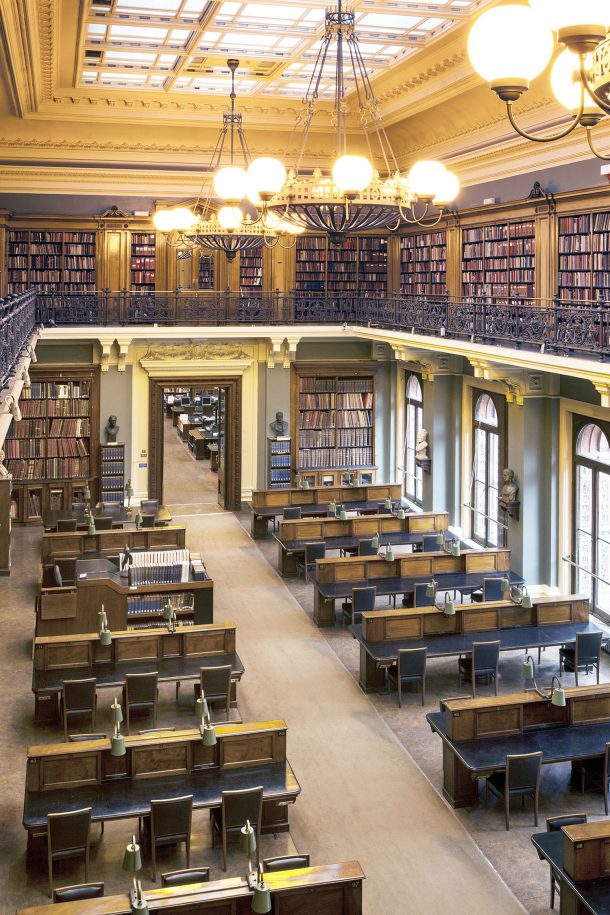As the National Art Library (NAL) reopens from 26 January, we also begin a transformation programme to take the library and archives into a new phase, at the heart of the V&A’s research ecosystem.
In 2021, as a result of the financial impacts of the coronavirus pandemic, the V&A underwent a major restructure, creating new curatorial departments and bringing the National Art Library and Archives together with the V&A’s Research Institute. Together with this move, we began a comprehensive review of the NAL and Archive services, led by two independent consultants, Dr Sarah Thomas and Anna Jobson. Sarah and Anna were tasked with examining how, in the extraordinary context of the pandemic, the library could – and should – move forward as a core part of the V&A’s mission, considering the place of the NAL within a national and international library landscape, how libraries have changed in response to the pandemic and wider trends in digital and technology and, in particular, how we might broaden access to the NAL and our archives.

The history of the NAL, widely recognised as a jewel of the V&A, is completely intertwined with that of the V&A. The museum’s first director Henry Cole considered a reference library of books relating to art and design to be fundamental to the nascent museum’s aim of improving the quality of British design. By 1852 the first full-time librarian was in post, and by 1865 the collection was being referred to as the ‘National Art Library’ – as still appears above the library’s entrance. Crucially, and like the museum, it was not to be solely the preserve of scholars, but open to all.
As with so many parts of the V&A’s collections, the library has developed organically over the last 170 years. Through gifts, purchases and bequests it has developed collections of important and unique items, including the largest collection of Charles Dickens’s manuscripts and working notes (the subject of active research), five of Leonardo da Vinci’s notebooks, collections of artists’ books, bookbindings, early printed books, illuminated manuscripts and much more. Simultaneously, it has sought to keep up-to-date with the wealth of publications produced in the many fields of art and design that relate to the V&A’s collections.
Over the decades, the library has served communities of students, museum professionals, practitioners and many more. Today, as Sarah and Anna’s report outlines, what readers need and ask of libraries has changed, with the pandemic accelerating many changes that were already in motion through advances in technology. The way that we consult – and indeed interact with – books and other textual or visual resources now assumes that some of these will be physical and some will be digital. And over the last two years, when trips to archives and libraries have been severely curtailed, we have been thankful for remote provision of materials, whether through on-demand scanning services, through digitised copies of out-of-print publications, or through films, talks and even virtual reading rooms that have opened up the collections of many institutions that we might never have had the chance to visit.
As the recent survey demonstrated, the NAL is much loved by those who know and use it. But there are many people who aren’t able to come to London, who would like to be able to use the NAL and archives, and whom we wish to be able to serve. In order to remain the valuable resource for art and design that we intend, we need to adapt and to be part of the changes that are already taking place across the library landscape. This means thinking hard about what we collect, in print and electronically; helping users to help themselves, whether onsite or remotely; developing new partnerships with other libraries to share and open up collective resources; improving access to and discoverability of online resources, in particular our unique and distinctive collections.
To that end, we are embarking on a transformation programme to take the National Art Library into its next phase, with renewed commitment to make our collections and resources accessible to all. We’ll shortly be appointing a Chief Librarian to lead this process, and we will be working behind the scenes to make our digitised collections more discoverable, to make more of our unique and distinctive collections, and to improve remote access to our resources. While financial constraints mean that we’re not able to act immediately on all of Sarah and Anna’s recommendations, we are committed to renewing and reinforcing the NAL, making it more sustainable, connected and inclusive, serving more people nationally and internationally as a fundamental part of the V&A’s 21st-century mission.
This doesn’t mean forgetting about our onsite readers. While we have all realised the potential of online access to collections through the pandemic, many of us have also longed to be back in the environment of a library, missing the spatial and sensory aspects that are often so much part of the reading, studying and writing experience. We’re delighted to be able to welcome readers back to the National Art Library’s reading rooms from 26 January, with increased opening hours and capacity. We’ll be opening every Wednesday from 11am and 5pm, with a walk-in service: for more information see here, and we’ll be increasing our opening hours later in the spring.
If you’re coming to the library, you’ll also have the chance to see our beautiful Fragmented Illuminations display, curated by NAL Curator Dr Catherine Yvard, and Language and Landscape in Artists’ Books, curated by NAL Assistant Curator Catriona Gourlay, just outside the library entrance. If you’re not able to come to South Kensington, do explore our online collections, blog posts and films, and look out for more of these over the coming months. We’ll be sharing more updates as we start to embark on our transformation.
[“source=vam.ac.uk”]


